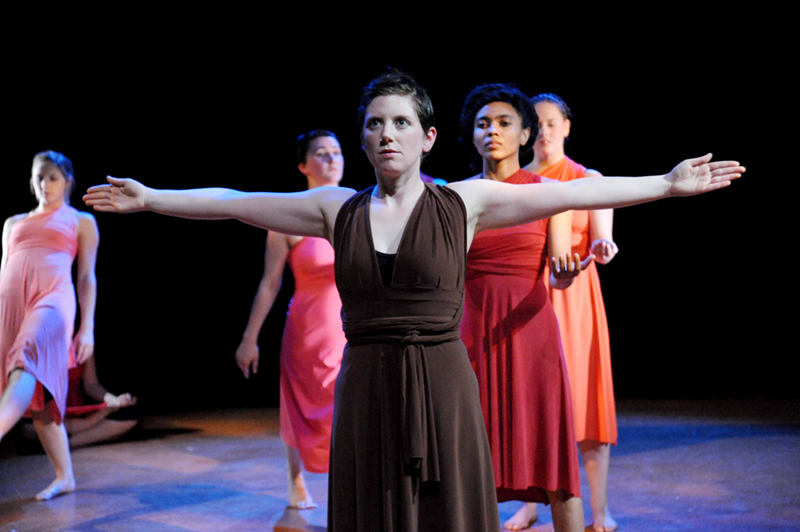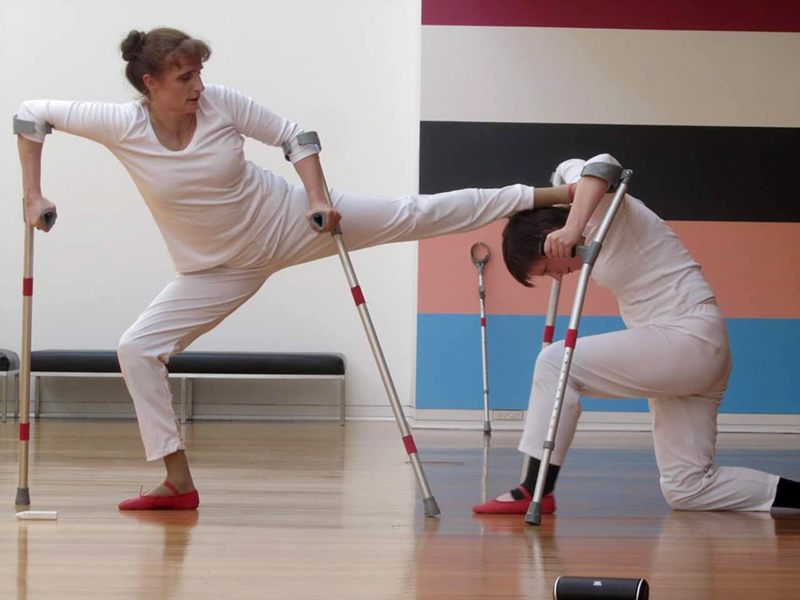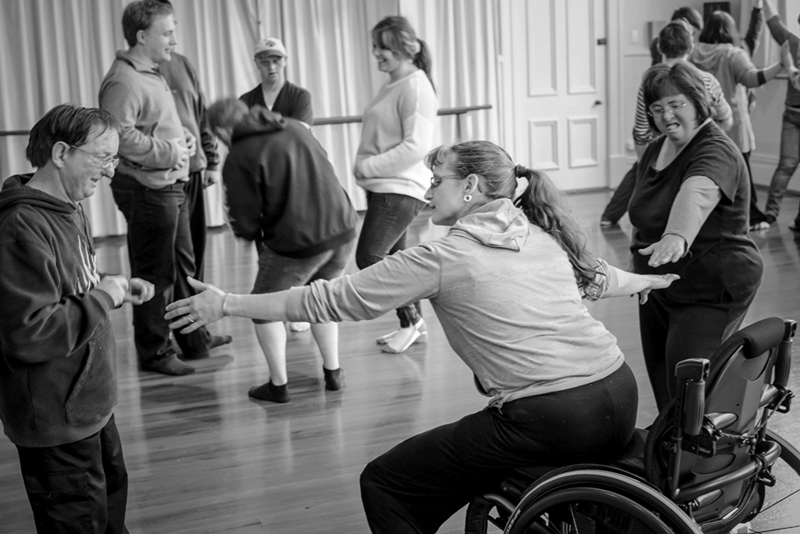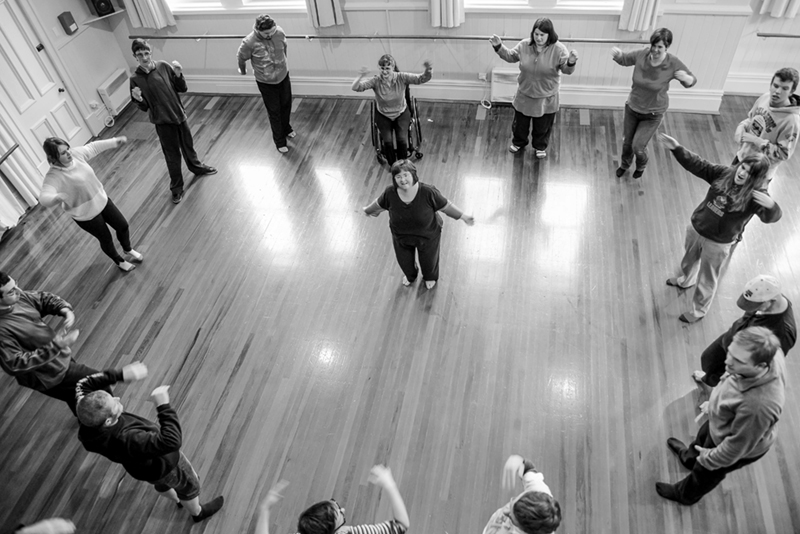Growing GASP! Dance Collective
An Interview with Hahna Briggs
BY EMMALY WIEDERHOLT
Hahna Briggs is the cofounder of GASP! Dance Collective, which provides inclusive dance for people with and without disabilities in Dunedin, New Zealand. Here, Hahna shares how GASP! Dance Collective got started, how it’s organized, and how it might evolve in the future.
Photo by Chris Sullivan
~~
Can you tell me a little about your dance history – what kinds of performance practices and in what contexts shaped who you are today?
I have been dancing most of my life. I started ballet at a very young age, and first became interested in inclusive dance in high school. I was running a show at my high school called the Smokefree Stage Challenge, a competition where each school would come up with a dance performance and we’d compete against each other. I was doing auditions for the choreography and a young woman showed up in her wheelchair. I didn’t know what to do. I had limited ideas around how someone in a wheelchair could dance. I did my best to include her, but it was superficial because of my limited knowledge.
That sparked my interest; I wanted to know more about how people with disabilities experience the world and how I can learn from them. I did my undergraduate degree on physical education, and I focused a lot on disability. At the time, the dance department was part of the PE department, so my degree incorporated dance.
After graduation, I moved away from dance and worked for the New Zealand Blind Foundation and in rehab. I missed dance and being part of the dance community so, after a few years, I decided to do my master’s in dance studies. It was an opportunity to revisit something I was passionate about. I read a lot about the history of inclusive dance, both in New Zealand and globally in the UK and America, looking at how different companies explore choreography and challenge stereotypes and definitions of dance.
How did GASP! Dance Collective come about?
After I did my masters, I applied for a Caroline Plummer Fellowship in Community Dance in 2013. Caroline Plummer was a student at the University of Otago who was passionate about community dance and died of cancer. One of her last wishes was to create this fellowship through her family and the university. It’s a six-month fellowship, and each fellow must propose working with a specific community and with a specific project in mind. I applied to work with people with disabilities as well as caregivers. Out of that fellowship, I grew a community of people who wanted to continue dancing. That’s when I decided to establish GASP! Dance Collective the following year in 2014.
Jenny Newstead is my colleague. She started with assisting our classes and now teaches. Jenny is a Paralympic gold medalist in swimming and is quite well-known in New Zealand. We connected while I was working on my masters; she was looking to get back into dancing for rehab and creativity. We worked together quite a lot for my masters, exploring concepts like deconstructing mobility devices and using them as tools of play, or letting her lead me sometimes instead of me leading her. We’ve developed quite a good working relationship; she’s supported getting GASP!’s classes up and running.
How is GASP! Dance Collective structured?
We run classes every week, and they are an hour long. We have two classes for adults age 16 and up, and we just started a class for young people under the age of 15. We’re hoping to add classes as the need arises. Due to space, we aim for about 12 participants per class. We prefer for people to sign up, but we allow people to drop in and out. A big chunk of our dancers followed me from the fellowship to GASP!, so most have been with us since the beginning. Most of our dancers have learning disabilities (which is preferred over “intellectual disabilities” in New Zealand). That’s in large part because of the connections I had during my fellowship were with organizations who support people with learning disabilities.
We aim to perform at least once a year. We look for opportunities to run our own performances as well as to be part of other projects. Last year, we were part of an exciting project for Matariki, the Maori New Year, which happens around May or June. A lot of different community dance groups were a part, and the theme was the Maori star system they use to navigate.
At the moment, I have some funding to do a dance film. We’ve also done site specific and theater performances. We haven’t done a dance film before, and I think it might be good for people for whom theater seating can be overwhelming.
What dance methods does GASP! Dance Collective mainly utilize?
I use strands of DanceAbility because both Jolt Dance and Touch Compass (physically integrated dance companies in New Zealand) have trained with Alito (the founder of DanceAbility), and I’ve taken workshops with both companies. We always start with a circle warm up. We mostly use improvisation. We do a range of exercises playing with different dynamics like making shapes in partners and sometimes just putting music on and having a fun jam. We also do light contact and weight sharing. Last year, for the Maori New Year performance, we did a lot of exploring movement around the theme of stars, navigation and water. I always like to have choreography we’re working on because I think it’s good to have something we’re making together. All the dancers get to contribute their ideas to the choreography.
How would you describe the dance scene in Dunedin, and how has GASP! Dance Collective fit into that scene?
The dance scene is interesting. It’s a small college town. We have a lot of dance studios that teach to a syllabus and do exams, whether it’s hip hop, ballet or contemporary. We also have folk clubs. I have a particular community I dance with; we go to each other’s classes and perform together. One friend teaches contact improvisation, another teaches West African, another runs a festival. We look for opportunities to perform, create and experiment together utilizing our separate interests. I often bring those dancers into GASP! classes. Because we predominantly have dancers with learning disabilities, I’ll have dancers without learning disabilities support the work. They can support our dancers with regards to remembering cues and sections and coming on and off stage. It’s great to collaborate with dancers in that way and bring their expertise in.
Over the past five years, how have you seen GASP! Dance Collective impact the community?
A lot of the dancers have been coming for so long. I notice how those dancers have gone on a journey in terms of their confidence within the group. One particular student was great the first class but was very quiet and would often sit out and only join in the last minute. Over time, he’s participated more and more. His mom has started to just drop him off instead of coming in with him. He laughs during class and does spontaneous movement. I’ve seen that progression in other dancers as well.
Family members really appreciate the performances; they appreciate the skill and confidence of their family members onstage. I’ve had feedback from a social worker who has known quite a few of my dancers, and she’s seen shifts and changes in the way they relate to others.
Participating in the Matariki performance last year was really good to show others the skill our dancers have and their dedication. Our dancers came to every rehearsal on time and were enthusiastic. They had a level of commitment that surprised a lot of people. The feedback was that people really enjoyed how much our dancers exuded joy in the way they dance, that you could tell we were all enjoying ourselves during the performance.
A lot of people who come watch us still say things like, “That’s so nice you’re doing this” or, “It must be so rewarding and therapeutic.” They see it as therapy instead of art. I think about how to challenge that more in the dance and get away from the therapy perspective. It’s not about fixing. It’s about offering a space where we can interact, have fun, and create together.
Photo by Chris Sullivan
What’s next? Do you have an upcoming project or focus you want to share more about? If not, how would you like to expand or grow your work in the future?
We have the film, which is going to be based on a beach in Dunedin called Saint Clair. We wanted a site-specific space that’s not hard to get to. Saint Clair is an interesting place because there’s a lot of coastal erosion. Because it’s so popular, people have tried to preserve the beach by building a seawall. It’s an interesting battle between human versus nature.
I got funding to have a movement research group and pay the dancers. I really want to build in leadership opportunities. For instance, we have class leaders who have the ability to understand the concepts and have a bit more independence. They get a discount on the fees in exchange for taking on responsibilities like satelliting newer students. They help us plan each term and offer feedback. It’s important to us to build in leadership opportunities and pay dancers for their time.
There’s an upcoming symposium happening in Dunedin at the University of Otago. When there are disability or dance conferences happening in town, it’s nice to show our work to build awareness. Being a university town, it’s great having those opportunities to share with more people.
In terms of growing GASP!, at the moment, we’re an informal group. My goal is to create a formal not-for-profit dance company to access more funding with a vision and plan for moving forward.
I’d also like to grow the classes and reach out to communities around Dunedin and expand out to smaller communities who might not have the opportunity to dance in this way. The Maori population is nearby and tend to be lower socioeconomic class with poorer health outcomes. These are barriers for participation. The responsibility is on us to offer opportunities, connections and networks with communities who aren’t involved with GASP! I would like to continue working with our great dancers as well as expand our pool of dancers so there is more diversity.
Any other thoughts?
Last year, Jenny noticed that in performances, though we’d both be listed as choreographers/directors in the program, the press wouldn’t acknowledge her. We ended up writing an article for DANZ Magazine where we wrote about ableism and some tips for challenging ableism in dance communities. That opened my eyes a lot about how she had been feeling with people congratulating me and ignoring her contributions.
~~
To learn more, visit gaspdance.wordpress.com.
Photo by Chris Sullivan




